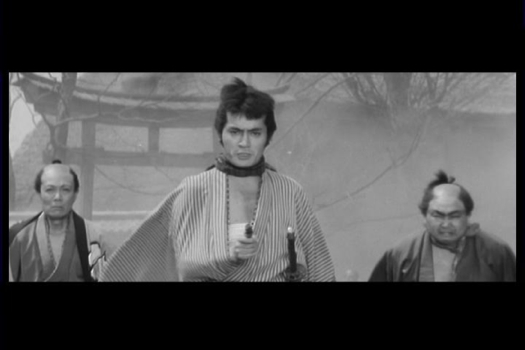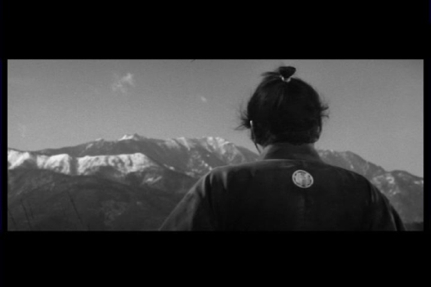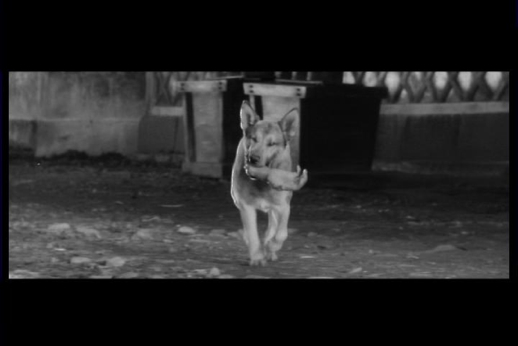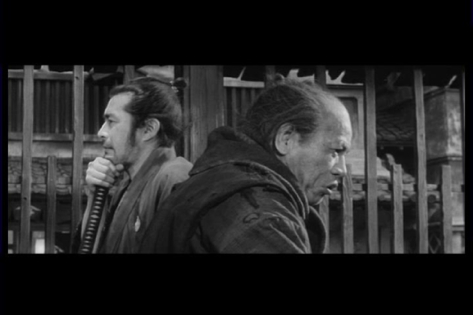Akira Kurosawa’s Yojimbo is a film about a ronin samurai who wanders into a town filled with chaos and corruption, and he soon feels he must find a way to clean up the place. This is a common theme in Western films; a man comes into town and shakes the place up until it looks the way he thinks it should. Now, while Yojimbo is not the typical Western movie, with a lot of guns and horses, it does have plenty of Western elements. Kurosawa has set the film in a dusty town, with one dirt road running through it, there is a bar where Sanjuro, the hero, hangs out at all there time, and everyone’s carrying a weapon at their hip. Also, when Sanjuro comes into town everyone is watching him from their windows and suddenly slam them shut; just as if a killer, looking for the sheriff, had just walking down the road. These are all common elements of the Western, and Robert Warshow gives a more in-depth analysis on what that entitles in his FTC essay “Movie Chronicle: The Westerner.”(703)
Warshow states, on page 703, that one of the “most successful creations of American movies” is “the Westerner.” Right away there is a contradiction with this article speaking about American movies, and Yojimbo being a Japanese samurai film. Kurosawa was incredibly fascinated with American Westerns and allowed that enjoyment to become projected across the screen; some of his movies were even to the point of being “too western.”
Anyway, Warshow goes on to state that “The Western hero…is a figure of repose.”(704) Repose meaning that the hero, a male, is at a state of peace. This is quite true of Sanjuro in the film; he is walking down dirt roads in Japan, traveling to an unknown destination. He is so at ease in life that when he reaches a point in the road where there is a three-way split, he tosses a stick into the air and whichever way the pointed end lands is the direction he shall take. Sanjuro’s tranquility is fully broken once he walks into the town, which will set the rest of the movie, and he sees a dog run by with a hand in its mouth. This truly creeps him out, and you can tell that by looking at his face. Now, Warshow states that the hero in Westerns are “lonely” and a little “melancholy.” But these two terms are not what they seem to be on the surface. Warshow explains that “his melancholy comes from the…recognition that life is unavoidably serious, not from disproportions of his own temperament (meaning his own emotions). And his loneliness is organic, not imposed on him by his situation but belonging to him intimately and testifying to his completeness.”(704) Sanjuro is a ronin, a wandering samurai with no master or lord; for that reason he is always alone. This samurai is also incredibly aware of the world around him, the corruption of it, that seriousness Warshow noted; and Sanjuro just doesn’t like what he sees in this small town.
Yojimbo’s leading man is fitting into the role of the Westerner quite nicely. Here’s another point from Warshow: “The Westerner is par excellence a man of leisure.” “Par excellence” means better or more than all others of the same kind. This is clearly true of Sanjuro skills, he can kill six guards in under fifteen seconds. The Westerner also seems to always look unemployed, even if he has a job. Most times he is “standing at a bar, or playing poker-a game which expresses perfectly his talent for remaining relaxed in the midst of tension.” (705) Sanjuro did not have a job, but he did reside in a bar; and instead of gambling with cards, he did so with his life.
One fact that really sets an American Western film and Yojimbo apart, is the fact that the latter had swords while the former has guns. Warshow states that “…guns constitute the visible moral center of the Western movie, suggesting continually the possibility of violence…”(705) Kurosawa just replaced the guns with swords, but those Western elements are still there. Violence is prone to happen in this town, and the fact that every individual who walks out into the street is carrying some sort of weapon only reinforces this point. The modern, 1996 version of Romeo and Juliet swapped swords with guns, and the movie was still seen as part of Shakespeare; the same thing happens in Yojimbo.
A few points that aren’t completely important to the comparison between Western films and Yojimbo, but are still kind of funny to think about; they’re even funnier because no one does think about these. Viewers never see where the hero sleeps at night, an interesting fact, the leading man never changes his clothing, and the Westerner looks for employment that is unproductive; all aspects of the character Sanjuro. He does take on jobs in the town, but he never does so for the reasons his employers believe he does.
An important question Warshow asks on page 706 is: “What does the Westerner fight for?” Justice and order? Warshow thinks so, but what about Sanjuro? He’s fighting for a better world; a cleaner, more pure place for people to live. After he trusted fate and followed the direction the stick pointed him in, Sanjuro soon came across a domestic crisis. A son wanted to go to the local town to gamble and make money rather than sit around as a farmer. Sanjuro watches the incident and the conversation between the mother and father carefully, and makes a few judgments of his own; this can be gathered from his facial expressions. He decides to take a look at this town that is spoken so lowly of.
There is corruption in Yojimbo’s town is due to an economic war taking place between the silk merchant and the sake dealer. On top of that two rival gangs have teamed up with each merchant and begin relentless fighting amongst each other. Essentially, what is happening here is Western influences have taken over this town. Instead of the town officials caring about the people, they only care about themselves. But more than anything else, they care about money and power. The most thriving job in town is that of the coffin maker, the Cooper; death has become a business for him. The Cooper is saddened after a massive slaughter has taken place, not on account of the lives that were lost, but because “When the fighting gets this bad, they don’t bother with coffins.”
But the vice does not start there, it has stretched from the top. Constable Hansuke, the peace officer of the small town, is the first to greet Sanjuro by asking him what side he wants to take in the economic war occurring in the town; the little man had already chosen his side. The bringer of peace is being paid to keep the fighting going.
The corruption has erupted into a matter that no one can handle and innocent civilians who don’t want anything to do with the the chaos are thrown into the mix. The only individuals who are not completely involved with the two competing groups are Gonji (the tavern keeper), the Cooper (coffin-maker), Kohei and his son (the wife/mother-less family) Nui (wife/mother/hostage), and of course Sanjuro. (There might have been one more person, but it is so hard to find a name to go with a face with these characters.) These individuals, excluding Sanjuro, have been forced to live in a town that promotes murder, gambling, deception, thievery, and kidnapping.
The crookedness of the town officials, and manufacturers leads to the corruption of the town’s people. This is not the fault of the citizens who live there, though; they are forced into this life of gambling simply to survive or at least get by. The first family we see in the film consists of a father and son arguing about going to town to live a better life. He wanted money and new clothes, precious items that could not be gained by working as a farmer; he eventually joins up with the pistol wielding Unosuke and his gang. Another example of the corruption this town emitted is the hopelessly sad father who appears with his son in Gonji’s tavern. He had lost a gambling match against Tokuemon, the sake brewer. As a result he lost his house and his wife, Nui (because of her beauty); she was taken to become Tokuemon’s personal sex slave. As if the mother wasn’t already having a hard enough time; she was dictated to work as a prostitute for Seibei at the brothel before she was forced back into the hands of sake brewer, Tokuemon.
Many times, the dishonorable men within the town are shown committing some horrible crime, and there will be fire around them to emphasize what they truly are, evil men. After Sanjuro kills the six guards, freeing the captive mother, Unosuke and the other members of the same gang burn the silk merchants house to the ground. Unosuke runs up toward the camera with a psychotic grin on his face, and of course his gun is poking out of his shirt, but his head is positioned right next to a window with flames pouring out. This image is reinforcing just how sinister this man really is. It happens again when Ushitora’s gang is burning more houses after Sanjuro’s escape from captivity. Ushitora and Unosuke stand there as a fire is leaping out of control behind them, reinforcing their villainy once again.
Once Sanjuro walks into the town, he wipes it clean of this corruption. By the end of the film there are only five people alive, Sanjuro, Gonji, the Cooper, Constable Hansuke and Tazaemon the silk merchant. Sanjuro is basically a warning to the entire world, that if corruption is not stopped then death will surely follow. The image of the aftermath of his own trickery is more than enough to explain that. Sanjuro’s sole purpose in this movie is to clean up the town; also a recurring theme in many Western films.
Another example of Western influence over the individuals in this film is Unosuke, the gunfighter. He comes onto the scene around the middle of the film. I don’t really know where he had come from, but his clothing and weapons produced some ideas.

Unosuke is the only character in the film to carry a pistol, and his clothes are unlike the rest of the casts’. His outfit (I can’t seem to find what it’s officially called) is designed with pin-stipes, which is not an item, along with the gun, that were bought in a small town like the one Yojimbo is set in. This hints at the fact that he has come from a Westernized region; a culture that has already felt American influence. Unosuke is trying to become the American cowboy, but in Japan.
Kurosawa’s use of music is very interesting to me. He tended to bring out the music when ever there was an action sequence coming, or when Sanjuro was moving around suspiciously; I just knew when terrible things were about to happen. When Ushitora is burning Seibei’s brothel, music began to play and suddenly Seibei’s men ran out swinging their swords; but their actions only end in their own deaths. The music many times was based around the actors movements or even their speech at times. He uses the Mickey Mousing technique with Ushitora is walking down the steps while Sanjuro is talking about being hired as a bodyguard.
Now, Yojimbo is an adaptation of The Glass Key, a novel by Dashiell Hammett. Many people would tie the film more to another Hammett novel Red Harvest, where a man comes into messed up town and plays two rival groups against each other; sounds pretty familiar. But there are aspects of this movie which pull it more toward a the later novel of The Glass Key, where, in a similar situation, a man named Ned Beaumont plays rival gangsters against each other.
The first, and most certainly memorable, example of the similarity between Yojimbo and The Glass Key is the scene where Sanjuro is beaten up by a couple of Ushitora’s henchmen. I feel like this scene from the novel was portrayed excellently in this adaptation of the film. This portion of the book was a bit lengthy while describing what Ned was going through and what he looked like. The 1942 film adaptation, also titled The Glass Key had a much shorter and less brutal scene of Ed, as he had his name changed for the film, was beaten up by Jeff. Kurosawa also tried to make a direct replica of Jeff in his film, and probably went farther than he needed to in casting the gigantic man with the wooded mallet. By simply looking at the two men, I think the comparison can be made fairly easily.
Secondly, Sanjuro is very much like Ned Beaumont, in that they are both wanderers who don’t really seem to belong anywhere. Since Sanjuro is a ronin, he literally has no where to be and is thus continuously drifting from place to place. He switched between the two competing gangs easily because of of his inability to fit in; one of the first thing that happens to Sanjuro once he enters the town is he’s confronted by one of the gangs. Similarly, Ned Beaumont was a transient individual in the novel. He never stayed in one place very long either, mainly because he did not belong to the gangster world he existed in. This is why it was so easy for him to move between the Paul Madvig and Shad O’Rory’s groups. Adding to the homelessness of Sanjuro, we never find out where he came from, or where he went after telling Gonji “See ya around.” He shows up walking down a dirt path, and leaves walking down the same one. Ned also doesn’t know where he is going at the end of the novel; he knew he was first going to New York, but not to stay there. Maybe Ned ended up in Yojimbo’s town and that was his hand the dog was carrying in the beginning. He was savagely bitten by O’Rory’s dog in the novel; maybe it happened again? Here’s a picture of the hand, maybe someone else down the road can tell if it’s Ladd’s or not.
A small resemblance, but a similarity none the less: There is a father and a son arguing about family issues in the beginning of the film. This part of the movie looks just like Taylor Henry and his father arguing in the novel The Glass Key. It is the scene we never saw in the book or the original adaptation.
A technique that both Hammett and Kurosawa used in creating their separate pieces is that instead of showing all of the brutality and death, many times we would only be allowed to see the aftermath. For instance, in both the novel and Yojimbo, the beating scenes for Sanjuro and Ned are not viewed in their entirety. We do view the protagonists being beaten at first, but these thrashings continued and we only see what the two men look like afterward, beaten and bloody. Usually, the viewers tend to see action sequences only when Sanjuro or Ned are around; this makes the viewer almost as if they and the protagonist are one in the same. They see what the hero sees and likewise for the opposite. In some scenes they are not watching the chaos outside; in the beating scene, they were unconscious (physically unable to see). Kurosawa plays with this throughout the film. While Gonji and the Cooper are carrying Sanjuro to the graveyard, he asks them to stop. They put the coffin down and he pops his head up. He can’t see anything, and neither can the audience; so Sanjuro is moved to a better spot, where he, and now the viewer, can see the fighting taking place.
Benjamin’s blog “Yojimbo and Ultra Violence” makes a great point in that this film is all about violence. Sanjuro came into this town for one reason, and one reason only…to kill everyone. And of course the Gonji, the old man, doesn’t get it; he never understands what is driving Sanjuro, at least until the end. I think Gonji might have figured out what Sanjuro was trying to accomplish, as lifeless bodies littered the street. The corrupt tyrants of the town had crumbled to the ground and now the village could be built back up to benefit the good of the world. This was, as I stated, the point of many Western films; a wandering man strolls into a debauched town and sets its leaders straight.
I also like where Mary-Carolyn was heading in her “Aesthetics” blog. She states that while The Glass Key is portrays the plot and its structure, while Yojimbo, being a self-conscious film, goes deeper into what’s underneath of the actions these protagonists take. I agree that The Glass Key adaptation doesn’t further the novel much more than other than showing a love story that was never even developed in the book. Yojimbo, on the other hand, digs deeper into heart of the matter of why Sanjuro takes on the world; because that is essentially what he is doing. The corruption of large industrial tycoons is stretching its green hand over everything it can reach. Sanjuro’s reasons for fighting back is to rid the town and, in a way, the world of evil. I wonder if that is the same thing (N)Ed is doing in The Glass Key novel and film. It’s a possibility, but only Dashielle Hammett, the one who started this whole thing, would know.
I believe Tyler and his title-that-says-it-all blog, “The old innkeeper: the decent human being” has got something good here. The old man is the voice of reason, although Sanjuro has his own reasons for doing things and Gonji is always left unheard. But he is the voice of the audience, telling Sanjuro what we would like to tell the wandering samurai. When Sanjuro is brutally beaten by Ushitora’s thugs, he crawls to Gonji’s tavern and the old man hides him and eventually takes him to safety. Through Gonji, we are essentially protecting Sanjuro while he’s in the most vulnerable state he has experienced thus far. We, the audience, want Sanjuro to be alright, since he is the one trying to preserve a better world for Gonji, and essentially all mankind, to live in. Gonji is the most human character in the film, and when he is captured, the entire world of good, reason, and innocence is put into danger. This is why Sanjuro comes back with the fury of millions; he is no longer a ronin wandering around. He had found his cause, even if was only temporary; Sanjuro was battling for the good of the world and his only true friend, Gonji. Gonji represented the world Sanjuro had apparently vowed to protect; and Sanjuro would have gone to the death for that man, because, at that point in time, Gonji was his master.




